Your online store is all set up. Your systems are fully tested and in place. What can go wrong?
As experienced dropshippers know, there are so many aspects involved in running an ecommerce business that some problems do get overlooked.
When they affect the way customers engage with your store, the result can sometimes take the form of bad online reviews, which could hurt your business.
From logistical delays because of the complexities of international shipping to a miscommunication with your supplier, there are plenty of unanticipated hiccups that can turn a positive shopping experience negative for your customer.
When that happens, you will want to mitigate the problem as quickly and as best as you can before it makes its way online and public.
But customer reviews are tricky. As we’ll see from these online review statistics, negative reviews can be damaging, but all-perfect review scores may also raise warning bells.
Without further ado, let’s dive into the ten online review statistics all business owners need to know in 2021.
Post Contents
- 1. Consumers Consult Reviews Online Before Making a Purchase
- 2. Authenticity of Online Reviews
- 3. Buyers Trust the Reviews They Read Online
- 4. Where Consumers Read Reviews
- 5. Average Number of Reviews Consumers Read Online
- 6. How Many People Leave Online Reviews
- 7. Customers Expect Businesses to Respond to Their Reviews and Quickly
- 8. Importance of Businesses’ Response to Online Reviews
- 9. Online Reviews Are Important for Local Businesses
- 10. On-Page Customer Reviews Lead to More Sales
- Conclusion
- Summary: Online Review Statistics
- Want to Learn More?



1. Consumers Consult Reviews Online Before Making a Purchase
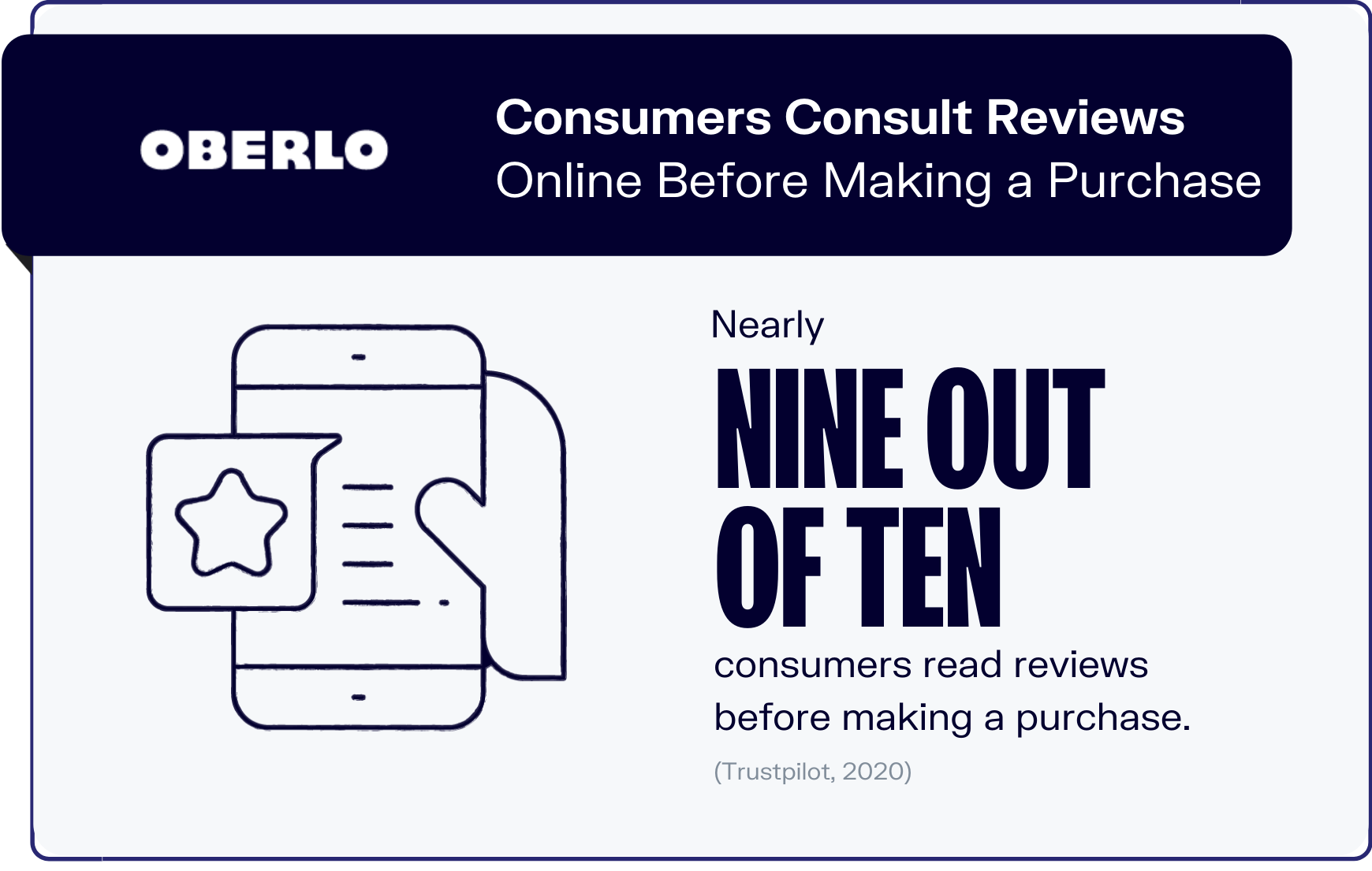
The first statistic will help you to understand the importance of reviews in a consumer’s purchase journey.
Nearly nine out of ten (89 percent) consumers worldwide make the effort to read reviews before buying products (Trustpilot, 2020).
Not only does this imply that reviews are an integral part of consumers’ purchase process, it also indicates a high level of confidence and faith that buyers have in fellow consumers’ opinions.
There doesn’t seem to be a big difference in reviews consumption between men and women. Just slightly more women (90 percent) read reviews compared to men (88 percent).
Interestingly, slight imperfections in review scores seem to hold more swaying power. More than half of consumers say review scores that are less than perfect appear more “authentic.”
In fact, six out of ten consumers say they will continue to do more research on products that have perfect, five-star reviews.
2. Authenticity of Online Reviews
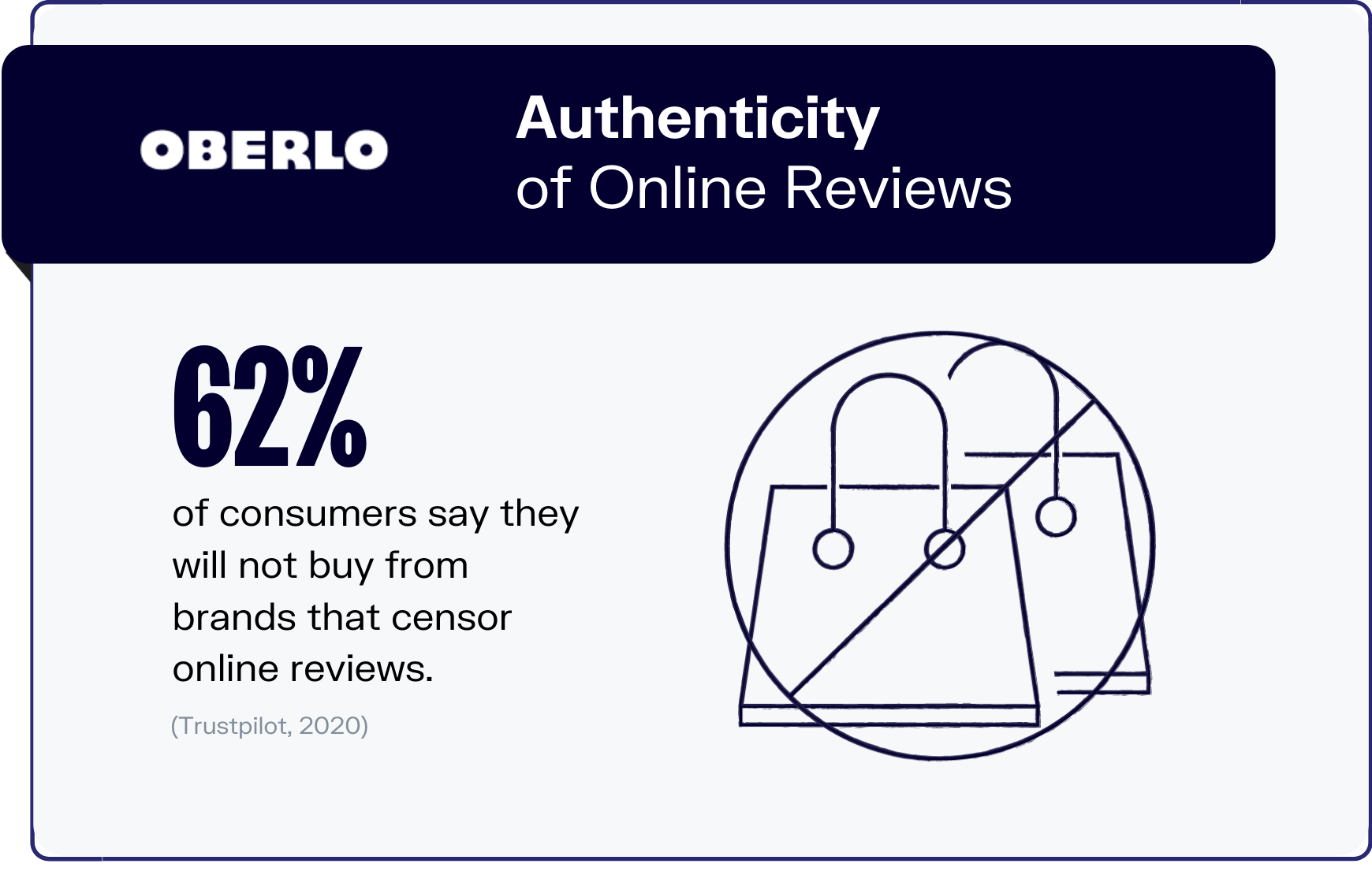
So then, how many people trust a business more after reading positive online reviews?
As it turns out, that depends.
Authenticity and transparency are important factors consumers look out for in reviews. As established in the previous statistic, reviews with perfect scores may do more harm than good.
That aside, ecommerce owners should also avoid manipulating their reviews in any way. That includes censoring negative reviews.
As online reviews statistics show, this is a practice that could greatly jeopardize business sales. As many as 62 percent of consumers say they will not support brands that engage in review censorship (Trustpilot, 2020).
The same goes for fake reviews, which are present in countless websites including major review sites like Google and Amazon. Statistics show that 62 percent of consumers have no tolerance for fraudulent reviews and believe that they should be removed.
3. Buyers Trust the Reviews They Read Online
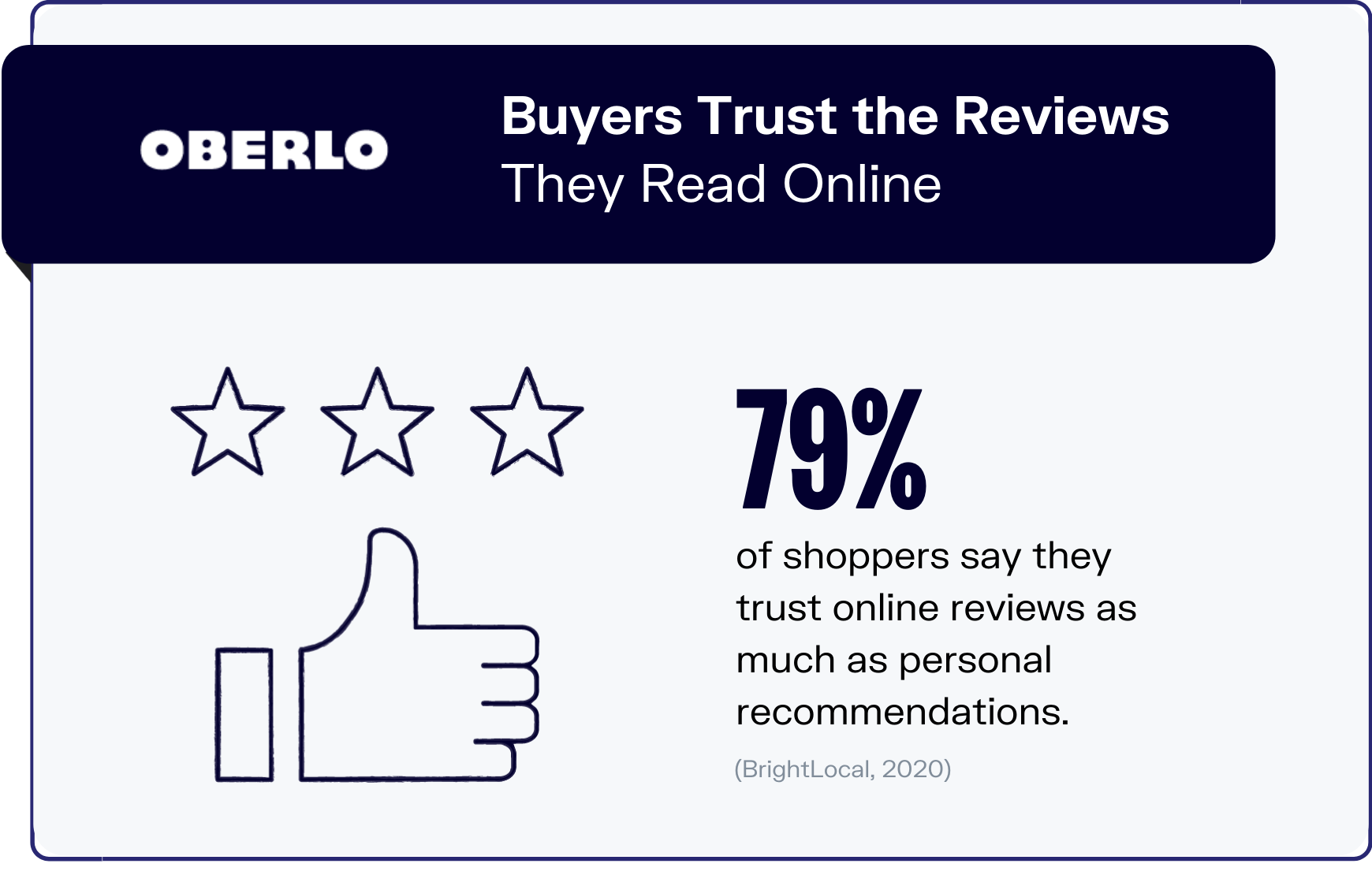
Although the power of online reviews still lags behind that of personal recommendations from family and friends, it continues to hold much influence over consumers with the exception of the older generation.
According to the latest online review statistics, nearly four in five (79 percent) consumers say they trust the reviews they read online as much as personal recommendations (BrightLocal, 2020).
This is three percentage points more than the previous year – an indication that increasingly more people are starting to trust online reviews as much as word-of-mouth.
However, it is important to note that the amount of influence reviews (both negative and positive) have on a business varies across industries.
For instance, as many as 87 percent of consumers believe that reviews are important when it comes to choosing which restaurants or cafés to patronize or which hotels or B&Bs to stay at. On the other hand, just 66 percent consider reviews to be important for clothing stores.
4. Where Consumers Read Reviews
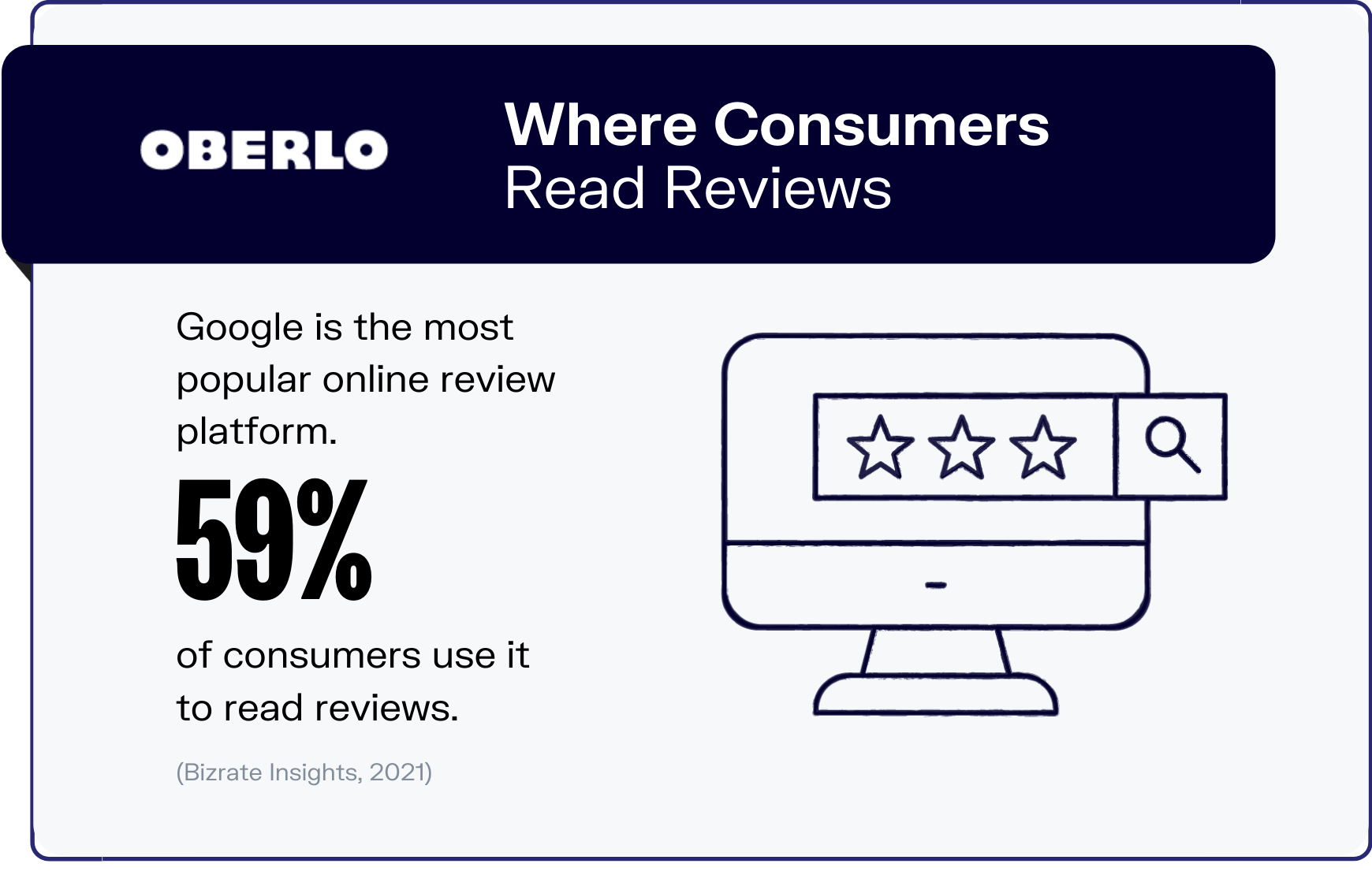
With so many review platforms on the internet, you can be sure that consumers aren’t only checking out reviews on your ecommerce website.
So then, where else do they go to read other customers’ reviews?
Google is by far the most popular channel people turn to for reviews, with approximately 59 percent of shoppers using it (Bizrate Insights, 2021). This is followed by Amazon with 57 percent.
Featuring reviews on your own ecommerce website is clearly not sufficient to convince customers to purchase from you. Only one in five consumers say they fully trust the reviews on brands’ websites, while a staggering 70 percent say they “somewhat” trust them.
The importance of reviews cannot be denied. But as these online review statistics show, it’s also crucial to diversify the places where customers can read reviews about your products and business. You’ll also want to make sure you’re actively responding to external review sites to manage your brand image.
5. Average Number of Reviews Consumers Read Online
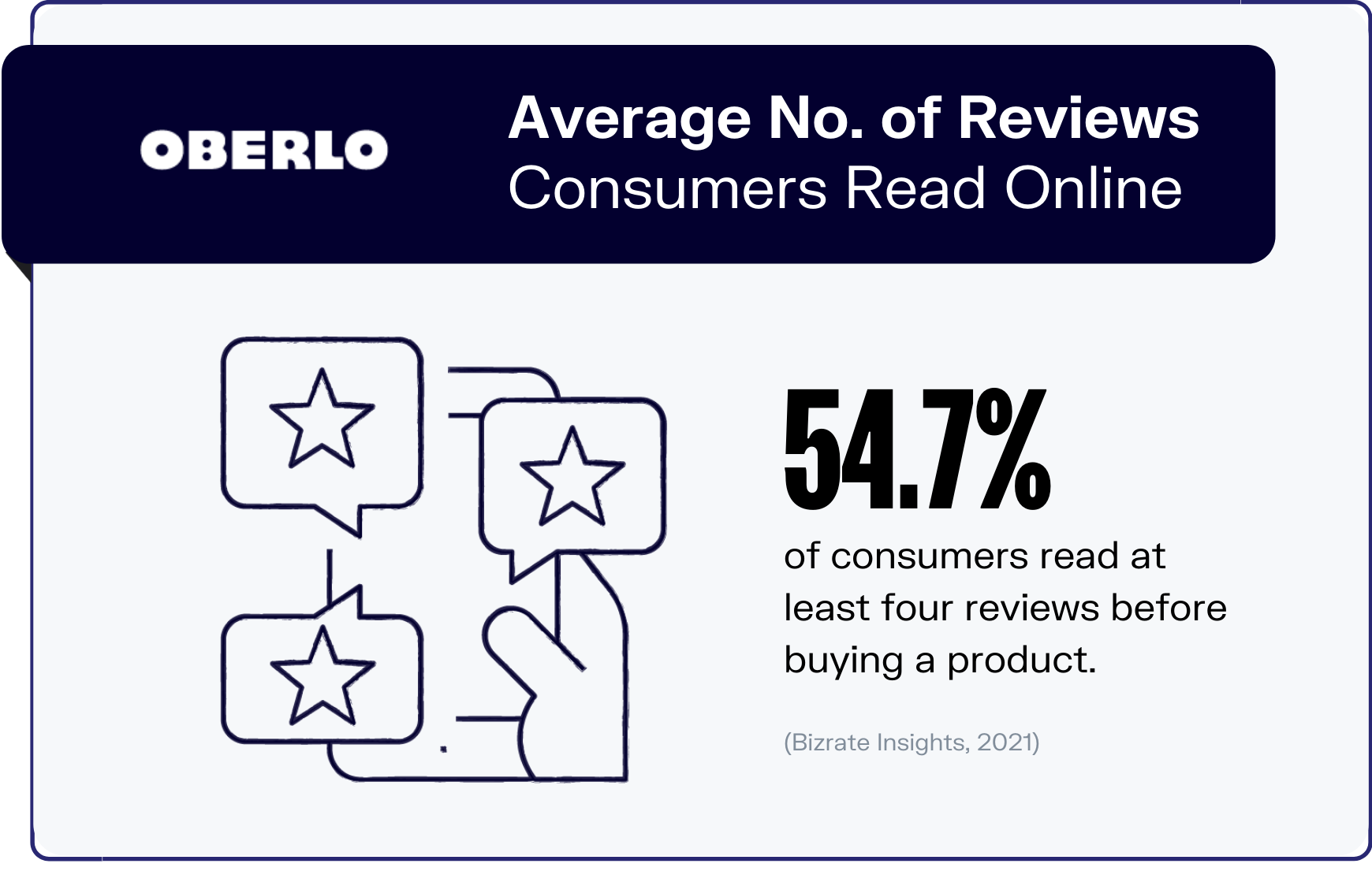
Most consumers who read online reviews don’t just stop at one. Online review statistics show that more than half of online shoppers (54.7 percent) read at least four product reviews prior to purchasing a product. Around 44 percent of them read three or fewer reviews (Bizrate Insights, 2021).
But this doesn’t mean that the more reviews your company or product has, the merrier. As a matter of fact, the number of reviews a product has generates different levels of trust in consumers.
According to the latest rating and review statistics, the majority of consumers (26.8 percent) say that products with between 11 and 50 reviews emit a higher sense of trust. In contrast, just five percent of consumers feel like they can trust products that have between 501 and 1,000 reviews.
6. How Many People Leave Online Reviews
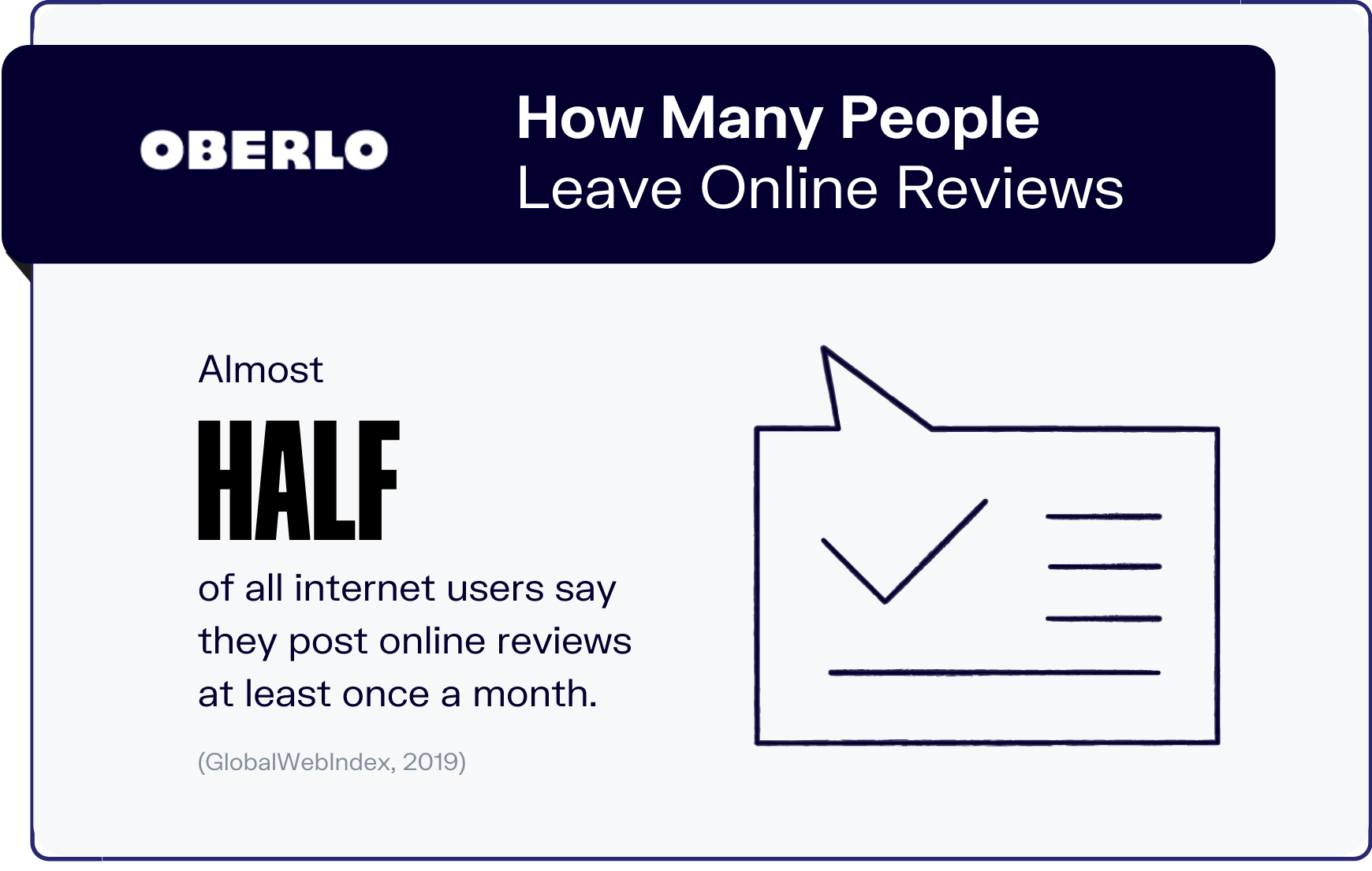
Not only are consumers reading reviews online before making a purchase, many of them are also leaving their own reviews.
Almost half (47 percent) of all internet users worldwide say they post reviews about a product, company, or service each month (GlobalWebIndex, 2019).
Though this is common behavior among online consumers of all ages, it is the younger generation that is more likely to do so.
For example, 53 percent of internet users aged between 25 and 34 post reviews at least once a month, while just 39 percent of those between 45 to 54 years old do so. In comparison, less than one-third (30 percent) of internet users from 55 to 64 post monthly reviews online.
7. Customers Expect Businesses to Respond to Their Reviews and Quickly
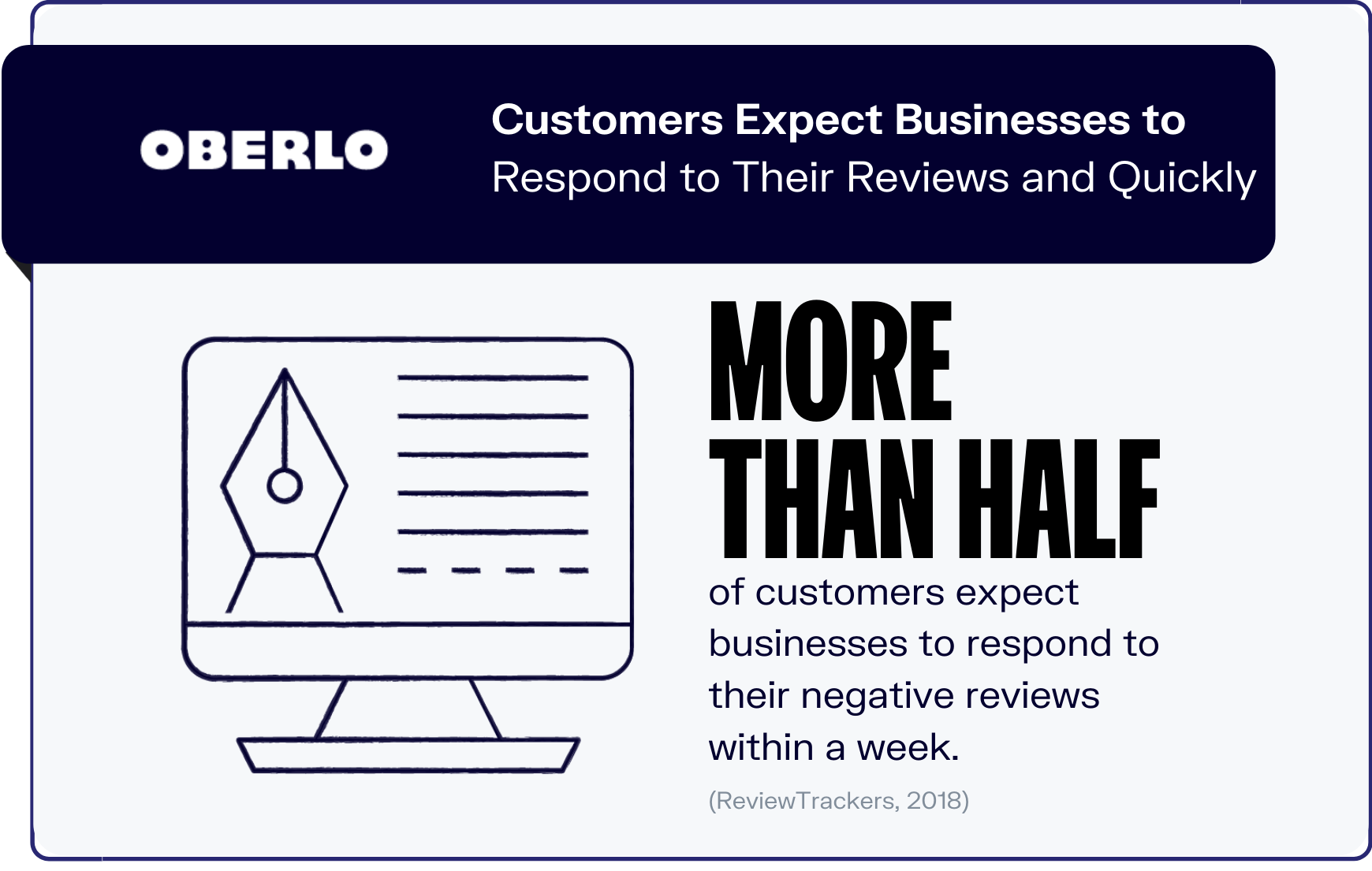
As the previous online review statistics have shown, shoppers rely pretty heavily on reviews when deciding what products to buy and which businesses to support.
But shoppers don’t just leave online reviews for the benefit of others. Statistics indicate that most of them also do so to lodge complaints with hopes of eliciting a response from the company. And they want them fast.
In fact, 53.3 percent of customers expect businesses to respond to their negative reviews within a week (ReviewTrackers, 2018). However, most of them are left disappointed: 63.3 percent of them say they’ve never heard back from a business about their review.
In the next statistic, we’ll go into why failing to respond to reviews could be detrimental for businesses.
8. Importance of Businesses’ Response to Online Reviews

When evaluating a business, consumers aren’t only influenced by the reviews that others leave but also how businesses manage their reviews. As many as 97 percent of shoppers who read reviews online also read responses from businesses (BrightLocal, 2019).
Responding to negative reviews is part of providing good customer service to your clients and it results in benefits for your business. Addressing their concerns shows that you, as a business, care for your customers.
It also helps to placate any angry customers, which increases the chances of retaining them. Plus, as many as 45 percent of consumers are more likely to support businesses if they see that they’ve responded to negative reviews.
Do not overlook the simple act of responding to a review. It could hurt you in the long run as bad experience with customer service is often shared with others.
9. Online Reviews Are Important for Local Businesses
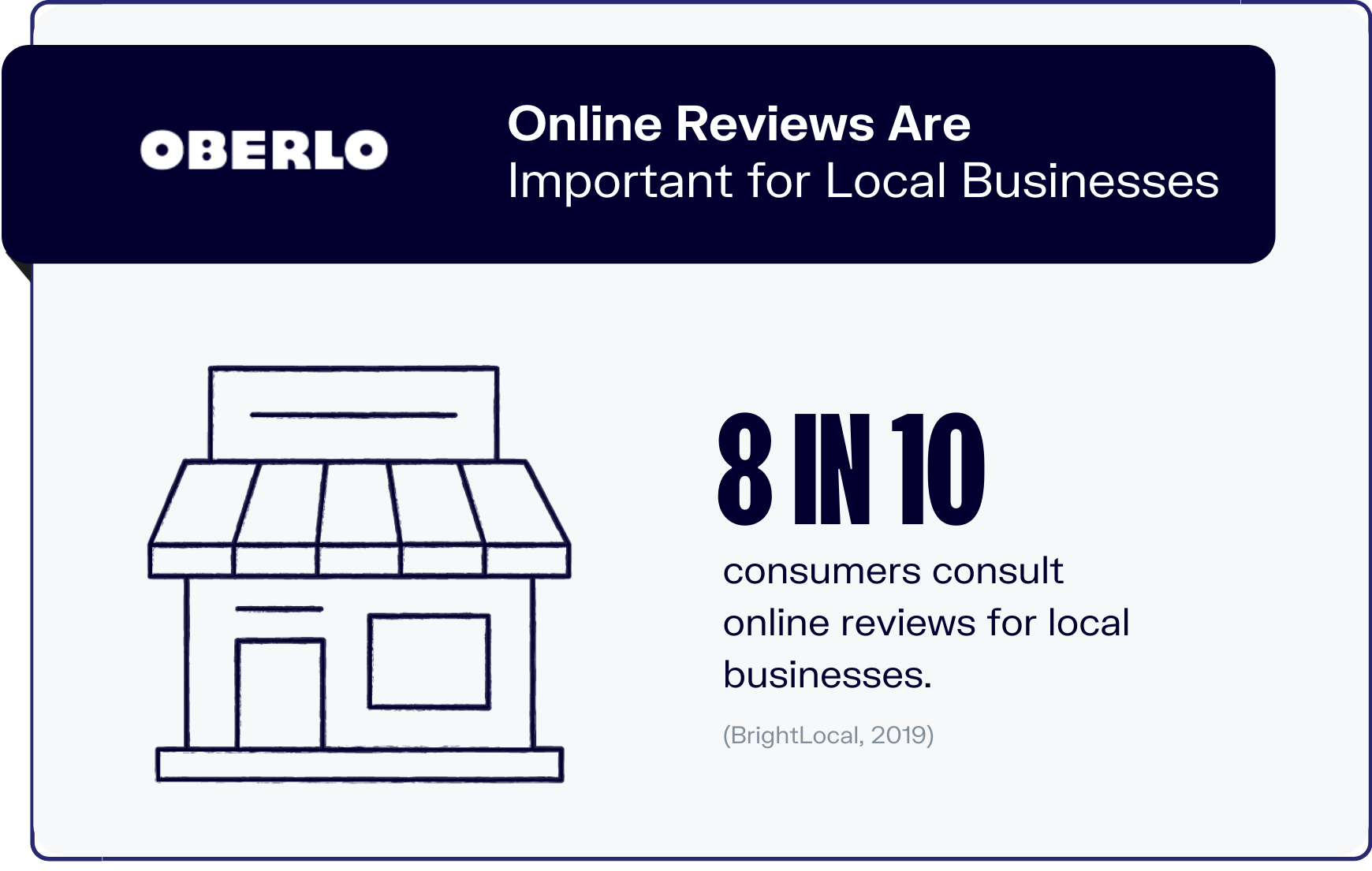
Reviews are also important for local businesses. As many as 82 percent of consumers say they consult them to find out more about local stores (BrightLocal, 2019).
This is a slight decrease from 86 percent from the previous year. But industry experts are hesitant to attribute this to decreasing reliance on online reviews and foresee that they will continue to be important to both local businesses and shoppers.
There’s, again, a stark difference in the way the older generation consumes reviews. While more than half (52 percent) of consumers aged from 18 to 54 claim to “always” consult reviews of local businesses online, just one in ten consumers over the age of 55 do so.
In fact, 29 percent of consumers over 55 say they never read online customer reviews of local stores, compared to just 17 percent for 18- to 34-year-old consumers and seven percent for 35- to 54-year-olds.
10. On-Page Customer Reviews Lead to More Sales
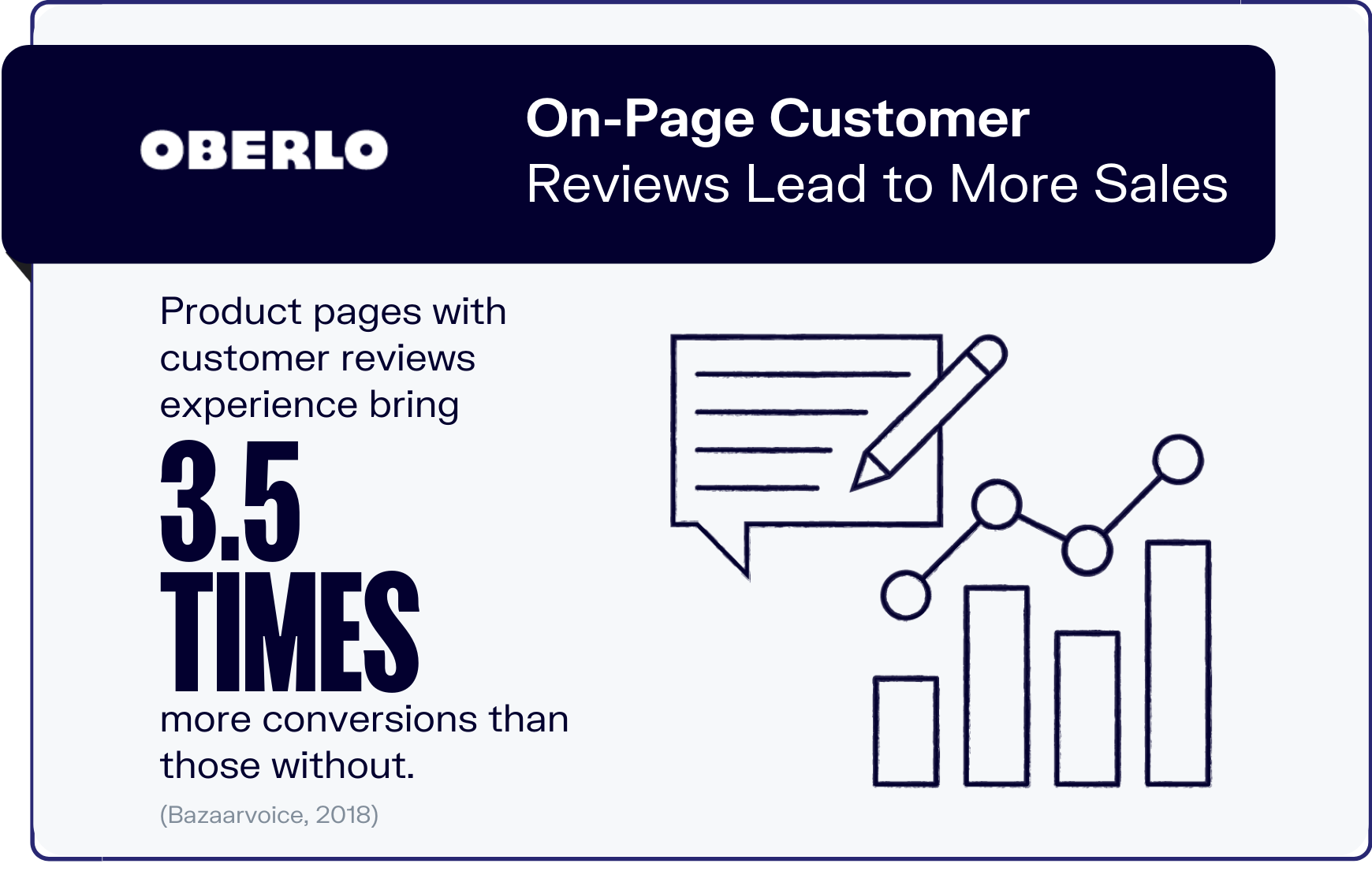
The above statistics should paint a clear picture of the importance of reviews for a business. If you want to take full advantage of reviews, don’t simply rely on external review platforms. Consider incorporating them onto your website and, in particular, your product pages to drive sales.
The latest online review statistics show that the conversion rates of product pages with reviews are up to 3.5 times higher than those that don’t (Bazaarvoice, 2018). This is regardless of whether shop visitors actually engaged with the reviews. Furthermore, these product pages also experience nearly 4.5 times more Revenue Per Visitor (RPV).
Let’s also not forget that online reviews can also boost SEO for your business and increase visibility on search engine result pages.
Conclusion
There you have it! These are some of the most eye-opening online review statistics to help you understand the importance of online reviews and how to best manage and implement a reviews system for your dropshipping business.
We hope that these have been useful to you and that you’ll use them to drive sales and grow your business.
What do you think of these statistics? How have you been dealing with business reviews? Do share your thoughts and experiences with us in the comments section below!

Summary: Online Review Statistics
Here’s a summary of the Online Review statistics you need to know in 2021:
- Nearly nine out of ten consumers read reviews before making a purchase.
- 62 percent of consumers say they will not buy from brands that censor online reviews.
- 79 percent of shoppers say they trust online reviews as much as personal recommendations.
- Google is the most popular online review platform. 59 percent of consumers use it to read reviews.
- 54.7 percent of consumers read at least four reviews before buying a product.
- Almost half of all internet users say they post online reviews at least once a month.
- More than half of customers expect businesses to respond to their negative reviews within a week.
- 97 percent of shoppers who read online reviews from other consumers also read responses from businesses.
- Eight in ten consumers consult online reviews for local businesses.
- Product pages with customer reviews experience 3.5 times more conversions than those without.



Want to Learn More?
- How to Start an Online Business In 2021: 10 Easy Steps
- BigCommerce vs Shopify (2021): Which One Is Better?
- Whois Lookup, Domain Availability & IP Search Tool by Shopify
- 15 Pricing Strategies to Boost Your Sales (With Examples)
Is there anything else you’d like to know about Online Review statistics and wish was included in this article? Let us know in the comments below!



